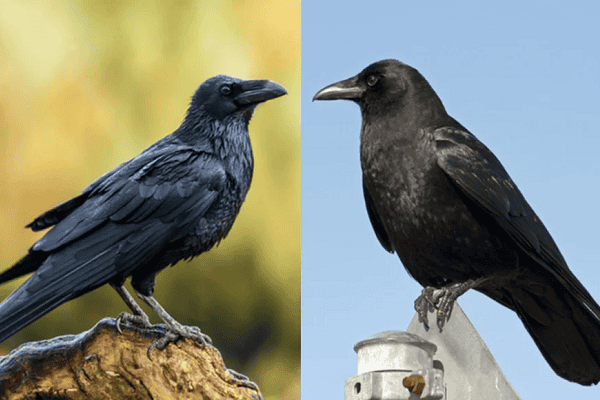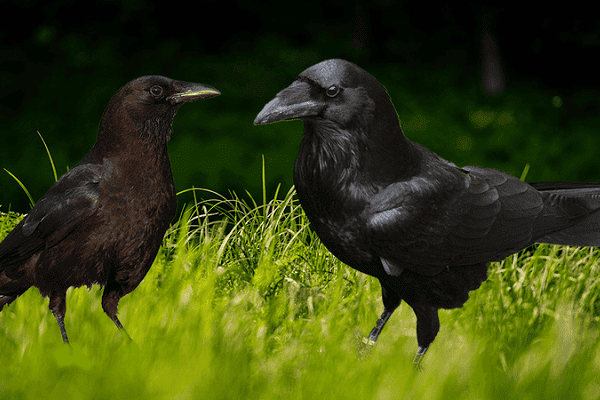Corvids, the family of birds known for their high intelligence and adaptability, include species like crows, ravens, and blackbirds. Despite their similarities, each species possesses distinct characteristics, behaviors, and cultural significance. In this article, we will delve into the physical traits, mating behaviors, habitats, cultural significance, threats, and conservation efforts related to crows, ravens, and blackbirds, aiming to provide a comprehensive understanding of these fascinating birds.
Physical Characteristics
When it comes to corvids, three species often stand out for their striking appearance and distinctive behaviors: the crow, the raven, and the blackbird. Let’s explore the physical characteristics that set them apart.
Size
- Crow: Crows are generally smaller than ravens and blackbirds. They measure about 16 to 20 inches (40 to 50 cm) in length.
- Raven: Ravens are the largest among the three. They can reach a length of 24 to 27 inches (61 to 69 cm).
- Blackbird: Blackbirds fall in between crows and ravens in terms of size, ranging from 8 to 10 inches (20 to 25 cm) in length.
Wingspan
- Crow: Crows typically have a wingspan of about 32 to 39 inches (82 to 100 cm).
- Raven: Ravens boast a much larger wingspan, measuring around 45 to 46 inches (115 to 117 cm).
- Blackbird: Blackbirds have a wingspan ranging from 12 to 15 inches (30 to 38 cm).
Color
- Crow: Crows have glossy black feathers with a purple or bluish tint in certain lighting conditions.
- Raven: Ravens also have black feathers, but their plumage may appear more iridescent and can show hints of green, purple, or blue.
- Blackbird: Despite its name, the blackbird isn’t entirely black. Male blackbirds have black plumage, while females have brown feathers with streaks.
Beak
- Crow: Crows have a sturdy, slightly curved beak that is typically black.
- Raven: Ravens have a larger and heavier beak, often with a more pronounced curve at the tip.
- Blackbird: Blackbirds have a smaller, pointed beak that is yellow or orange in color.
Bird Calls
- Crow: Crows are known for their “caw” sound, which is loud and harsh. They can produce a variety of calls, each with its own meaning.
- Raven: Ravens have a more varied repertoire of calls compared to crows. They can mimic other sounds and even human speech.
- Blackbird: Blackbirds produce melodious, flute-like songs, which are quite distinct from the calls of crows and ravens.
Related Article: Male Vs. Female Cardinal – What Are The Differences?
Reproduction and Mating
Understanding the mating and reproductive behaviors of these birds gives us insights into their family dynamics and population growth.
Mating Cycles
- Crow: Crows typically mate for life and form strong pair bonds. They breed during the spring.
- Raven: Ravens are also known for forming long-term pair bonds, and their breeding season is similar to that of crows, occurring in spring.
- Blackbird: Blackbirds also breed during the spring, but they are less likely to form long-term pair bonds.
Clutch Sizes
- Crow: Crows usually lay 3 to 6 eggs per clutch.
- Raven: Ravens have smaller clutch sizes, usually ranging from 3 to 7 eggs.
- Blackbird: Blackbirds have larger clutches, with typically 4 to 6 eggs.
Parenting Behaviors
- Crow: Crows are highly intelligent and cooperative parents. Both parents participate in feeding and protecting the young.
- Raven: Ravens exhibit complex parenting behaviors and are known to be attentive and caring parents.
- Blackbird: Blackbird parenting behaviors vary, but females are generally responsible for incubation, while males may help with feeding.
Visit: Caw-some Curiosities: 21 Fascinating Facts About Crows

Life Expectancy and Common Predators
Understanding the average lifespan and the threats these birds face is crucial for their conservation.
Life Expectancy
- Crow: In the wild, crows can live up to 7 to 8 years, but some have been recorded to live beyond 20 years in captivity.
- Raven: Ravens have a longer lifespan than crows. In the wild, they can live up to 10 to 15 years, and in captivity, they have been known to live over 40 years.
- Blackbird: Blackbirds have a relatively short lifespan, averaging around 2 to 3 years.
Common Predators
- Crow: Young crows may fall prey to owls, hawks, raccoons, and domestic cats.
- Raven: Ravens are formidable birds and have few natural predators. Young ravens may be vulnerable to larger raptors.
- Blackbird: Blackbirds face threats from birds of prey, snakes, and mammals like cats and foxes.
Habitat
Understanding the preferred habitats and nesting sites of these birds helps us appreciate their adaptability and role in the ecosystem.
Preferred Habitats
- Crow: Crows are highly adaptable and can be found in a wide range of habitats, from urban areas to forests and farmlands.
- Raven: Ravens prefer more remote and rugged landscapes, including forests, mountains, and coastal cliffs.
- Blackbird: Blackbirds are commonly found near wetlands, marshes, and water bodies, but they are also seen in gardens and urban parks.
Nesting Sites
- Crow: Crows build their nests in trees, usually near human settlements.
- Raven: Ravens build large, sturdy nests made of sticks and other materials in high trees or on cliffs.
- Blackbird: Blackbirds often build their nests close to the ground in shrubs or dense vegetation.
Seasonal Migration Patterns
- Crow: Crows are generally non-migratory birds, but they may make short-distance movements in search of food.
- Raven: Some raven populations undertake seasonal migrations, especially in search of food during harsh winters.
- Blackbird: Blackbirds are often migratory birds, and their migration patterns depend on the availability of food and climate.

Cultural Significance and Folklore
The appearance of these birds in various cultures has inspired a range of beliefs and artistic expressions.
Cultural Significance
- Crow: In many cultures, crows are associated with intelligence, mystery, and trickery. They are sometimes seen as messengers or omens.
- Raven: Ravens hold significant roles in mythology and folklore, often symbolizing wisdom, death, or creation.
- Blackbird: Blackbirds have been featured in folklore and literature, often representing themes of freedom and renewal.
Representation in Art, Literature, and Mythology
- Crow: Crows have appeared in various literary works and artworks, often embodying contrasting traits like wisdom and deceit.
- Raven: Ravens have a strong presence in mythology, especially in Native American and Norse folklore, where they are often linked to creation stories and gods.
- Blackbird: Blackbirds are mentioned in folk songs, poetry, and mythology, where they symbolize change and transformation.
Symbolism and Meaning
- Crow: Crows are sometimes seen as symbols of transformation, adaptation, and even luck or bad omens.
- Raven: Ravens are often associated with wisdom, mystery, and foresight. In some cultures, they are seen as protectors or guides.
- Blackbird: Blackbirds are symbols of freedom, intuition, and the cyclical nature of life.
Visit: Everything About Owls Legs: Facts, Types, Size, & Features
Threats and Conservation Efforts
Understanding the challenges these birds face and the measures in place for their protection is essential for their survival.
Threats
- Crow: Crows face threats from habitat destruction, human persecution, and pesticide poisoning.
- Raven: While ravens have fewer natural predators, they are still vulnerable to habitat loss and disturbance.
- Blackbird: Blackbirds face threats from habitat destruction and collisions with buildings.
Conservation Efforts
- Crow: Crows are not considered endangered, but their conservation is intertwined with the protection of the ecosystems they inhabit.
- Raven: Ravens have stable populations and are not considered endangered. However, monitoring their habitats is essential for long-term conservation.
- Blackbird: Some blackbird species face conservation concerns, and efforts are made to protect their habitats and raise awareness about their importance.
Potential Impact
- Crow: As scavengers, crows play a crucial role in maintaining ecological balance by cleaning up carrion and other waste.
- Raven: Ravens’ presence in ecosystems can influence prey populations and contribute to seed dispersal.
- Blackbird: Blackbirds contribute to insect control and seed dispersal, making them ecologically important.
Is a Blackbird the Same as a Crow?
No, blackbirds and crows are different species. Blackbirds belong to the Turdidae family, while crows are members of the Corvidae family. They differ in size, color, behavior, and habitats.
Are a Crow and Raven the Same Bird?
No, crows and ravens are different species belonging to the same Corvidae family. They have distinct physical characteristics, behaviors, and habitats.
Is Crow Better Than Raven?
The concept of “better” depends on the context. Crows and ravens have unique roles in their ecosystems, and each has its own ecological significance.
Why Is a Crow Called a Raven?
The naming of birds can sometimes be confusing, but crows and ravens are distinct species with different names based on their taxonomic classification and physical characteristics.
How Long Do Ravens Live?
Ravens have relatively long lifespans compared to many other bird species. In the wild, they can live up to 10 to 15 years, and some have been known to live much longer in captivity.
Do Blackbirds Migrate?
Yes, many blackbird species are migratory birds. Their migration patterns vary depending on their geographic location and the availability of food and suitable breeding grounds.
Unlocking the Secrets of Raven, Crow, and Blackbird
Studying the fascinating world of crows, ravens, and blackbirds provides us with valuable insights into avian ecology and behavior. These intelligent and adaptable birds continue to capture our imagination and remain an integral part of our cultural and natural heritage. By understanding their unique traits and vulnerabilities, we can work towards better conservation strategies to ensure their survival for generations to come. For more information about Birds Visit BirdingSky.org
FAQs About Corvids
Q1. Is a blackbird the same as a Crow?
While both belong to the same family, blackbirds and crows are different species with distinct characteristics.
Q2. Are a crow and a raven the same bird?
No, crows and ravens are separate species, albeit closely related. They differ in size, calls, and habitat preferences.
Q3. Is Crow better than Raven?
There is no inherent judgment of superiority between the two. Both crows and ravens possess unique qualities that make them valuable in their respective ecosystems.
Q4. Why is a crow called a raven?
The confusion might arise due to their similar appearance, but they are distinct species with different names and characteristics.
Q5. How long do ravens live?
Ravens can live up to 20 years in the wild, demonstrating impressive longevity.
